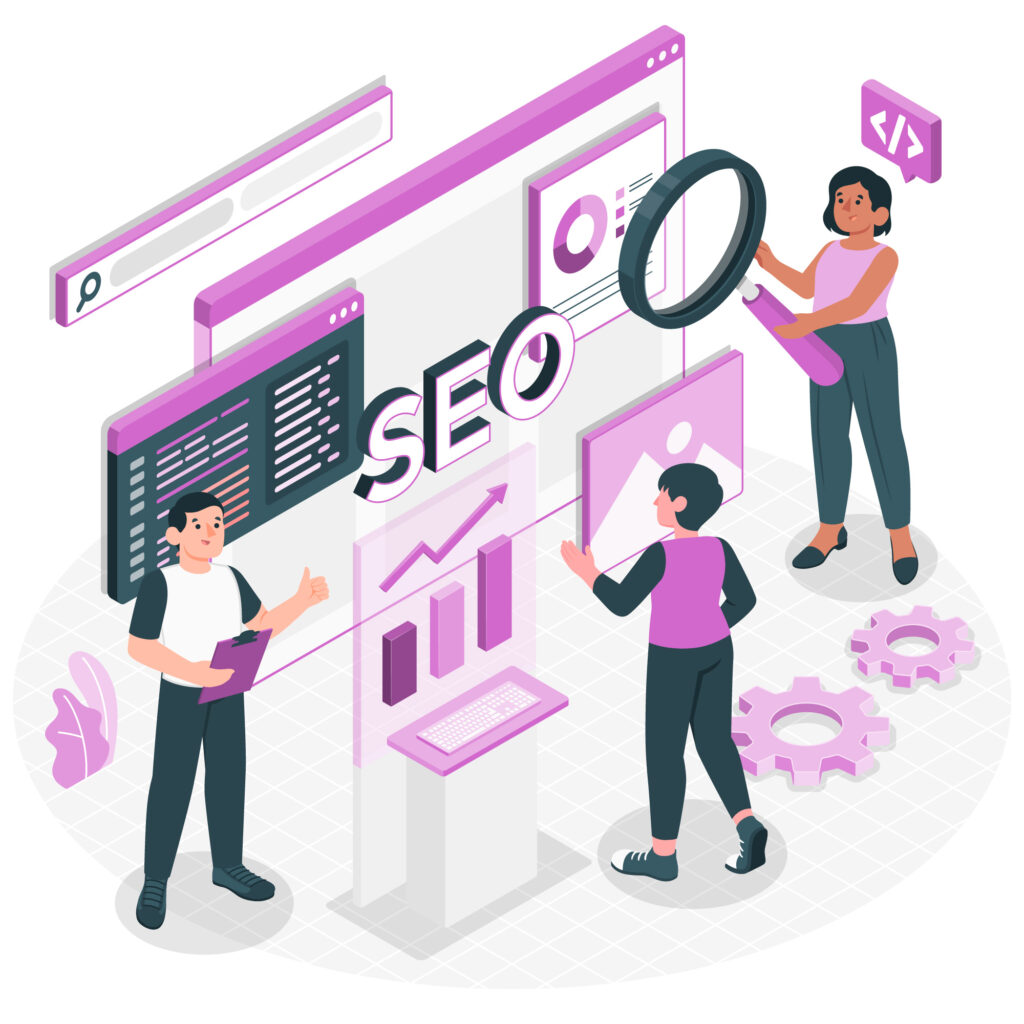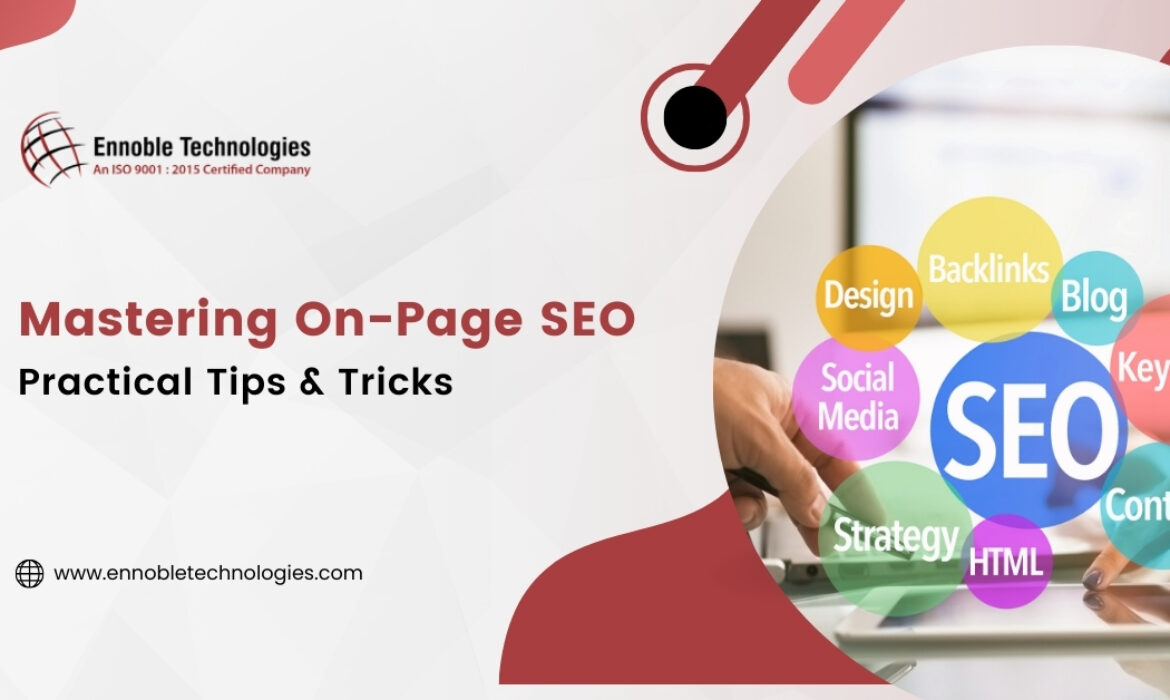Mastering on-page SEO (Search Engine Optimization) is crucial for improving your website’s visibility and ranking on search engines. Here are practical tips and tricks to help you optimize your on-page elements effectively:
Mastering On-Page SEO – Practical Tips & Tricks
Keyword Research:
- Begin by researching relevant keywords for your content using tools like Google Keyword Planner or SEMrush.
- Focus on long-tail keywords that are specific to your content and have moderate search volume.
Title Tags:
- Craft compelling and concise title tags (around 60 characters) that include your primary keyword.
- Ensure the title is relevant to the content and encourages clicks.
Meta Descriptions:
- Write engaging meta descriptions (around 155-160 characters) that summarize the content and include a call-to-action.
- Although meta descriptions don’t directly impact rankings, they influence click-through rates.
URL Structure:
- Create clean and SEO-friendly URLs that include relevant keywords.
- Avoid using generic URL structures with random strings of numbers or characters.

Header Tags:
- Use header tags (H1, H2, H3, etc.) to structure your content logically.
- Include your main keyword in the H1 tag and use H2, H3 tags for subheadings.
Keyword Placement:
- Naturally incorporate your target keywords in the first paragraph and throughout the content.
- Avoid keyword stuffing, as it can harm your SEO efforts.
Image Optimization:
- Optimize image file names and use descriptive alt text to make images search engine-friendly.
- Compress images to ensure faster page loading times.
Content Quality:
- Create high-quality, relevant, and valuable content that addresses user intent.
- Longer content often performs well, but focus on providing value rather than just length.
Internal Linking:
- Add internal links to relevant pages within your website to improve navigation and distribute link equity.
- Use descriptive anchor text that includes keywords.
User Experience (UX):
- Ensure a positive user experience by optimizing page load speed and mobile responsiveness.
- Use clear and concise formatting with bullet points, headings, and easy-to-read text.
Schema Markup:
- Implement schema markup to provide search engines with additional information about your content.
- This can enhance your search results with rich snippets.

Social Media Integration:
- Integrate social sharing buttons to encourage users to share your content.
- Social signals can indirectly impact search rankings.
Regular Content Updates:
- Keep your content up-to-date to show search engines that your site is active and relevant.
- Refresh old content and add new information when necessary.
Page Speed Optimization:
- Compress images, leverage browser caching, and use content delivery networks (CDNs) to improve page load speed.
- Google considers page speed as a ranking factor.
Analytics and Monitoring:
- Use tools like Google Analytics and Google Search Console to monitor your website’s performance.
- Analyze user behavior, track keywords, and make data-driven adjustments.
By implementing these on-page SEO tips and tricks, you’ll enhance your website’s visibility, provide a better user experience, and ultimately improve your search engine rankings. Regularly monitor and adjust your strategy based on performance data and industry trends.
The Foundation: Choosing the Right Keywords
Selecting the right keywords is the cornerstone of effective on-page SEO. Conduct thorough research to identify phrases aligned with your content. Tools like Google Keyword Planner can assist in uncovering high-ranking keywords that resonate with your target audience.
Crafting Captivating Titles: A Magnetic Force
Your page title is the first impression on both users and search engines. Craft compelling titles that not only include your primary keyword but also entice readers. A captivating title sets the stage for increased click-through rates.
Headers That Speak Volumes
Utilize headers strategically by incorporating relevant keywords. H1 tags should encapsulate the main topic, while subsequent headers (H2, H3, etc.) can delve into subtopics. This hierarchy not only aids SEO but also enhances the readability of your content.
Meta Descriptions: Your 155-Character Elevator Pitch
Craft concise and engaging meta descriptions that encapsulate the essence of your content within 155 characters. Include primary keywords naturally to entice users to click through. Think of it as your digital elevator pitch – short, impactful, and enticing.
URL Optimization: Simplify for Success
Optimize your URLs by keeping them concise and reflective of your content. Include relevant keywords, separate words with hyphens, and avoid unnecessary characters. A clean and straightforward URL contributes to both user experience and search engine visibility.

Image Alt Text: The Silent SEO Contributor
Don’t overlook the power of image alt text. Describe your images using relevant keywords to enhance accessibility and provide search engines with additional context. Alt text is a subtle yet effective way to boost your on-page SEO efforts.
Content is King: Quality Over Quantity
Ensure your content is not only informative but also engaging. Create in-depth, valuable content that addresses user queries. Google favors content that satisfies user intent, so focus on quality over quantity to secure a prominent place in search results.
User-Friendly Experience: Mobile Optimization
With the majority of users accessing the internet via mobile devices, optimizing your website for mobile is non-negotiable. Ensure responsive design, fast loading times, and a seamless mobile experience to enhance both user satisfaction and SEO performance.
Internal Linking: The Web of Connectivity
Integrate internal links strategically to connect relevant pages within your website. This not only aids in navigation but also distributes link authority, boosting the SEO value of your content. Foster a web of connectivity that keeps users exploring your site.
Analytics: Your SEO Compass
Regularly monitor your website’s performance through analytics tools. Track user behavior, page views, and bounce rates. Analyzing this data provides insights into what is working and allows for adjustments to optimize your on-page SEO strategy continuously.
Conclusion:
In conclusion, mastering on-page SEO requires a strategic approach encompassing keyword research, compelling titles, headers, meta descriptions, URL optimization, image alt text, quality content, mobile optimization, internal linking, and diligent analytics. Implement these practical tips and tricks to unlock the full potential of your website in the competitive digital landscape.
Also Read: 10 On-Page SEO Mistakes You Must Avoid – Ennoble Technologies
Canonical Tags Usage Content Optimization Tips Header Tags SEO HTML Tags Optimization Image SEO Guidelines Internal Linking Strategies Keyword Placement Tactics Mastering On-Page SEO Meta Tags Optimization Mobile-Friendly SEO On-Page SEO Techniques Page Speed Optimization Rich Snippets Optimization Schema Markup Implementation SEO Audit Checklist SEO Content Formatting SEO for User Experience SEO Optimization Strategies SEO-Friendly URLs Structured Data Markup Title Tag Optimization Website SEO Best Practices





Wow, superb blog format! How lengthy have you ever been running a blog for?
you make blogging glance easy. The full look of your
web site is magnificent, as smartly as the content!